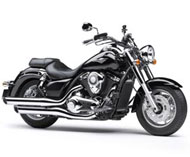
Wonders never cease
The wizards of motorcycle design have come up with the goods again
Words: Peter Thoeming, Joern Delfs
Photos: Manufacturers, Joern Delfs, Peter Thoeming
You’ve probably been to an Australian bike or even car show and probably really enjoyed it. Fair enough, too. But visiting one of the big overseas shows – Milan, Cologne, Paris or Tokyo – is like going on a date with Gisela Bündchen after taking out the girl next door. Potentially just as much fun, in a way, but on a noticeably different scale and, of course, significantly more expensive as well.
For the first time ever, the Cologne show INTERMOT attracted more than 200,000 visitors in 2008. They came from 110 countries. Nearly one-third of them were trade visitors and 35 per cent of these came from outside Germany. A total of 1068 companies from 36 countries had displays.
Milan’s EICMA show did even better, with about 500,000 visitors. That’s equal to the 2007 figure, no mean feat in a tough environment. There were 1002 exhibitors from 33 countries, filling some 140,000 square metres of hall space.
“The biggest two-wheeled show in the world lived up to expectations yet again, satisfying exhibitors, trade visitors and the huge number of public visitors,” EICMA director general Costantino Ruggiero said.
“The event has definitely found its place and we should be able to create even better synergy between the bicycle and motorbike sectors, perhaps via common themes such as urban mobility.”
Both shows also offered a huge variety of outdoor activities, but we didn’t have time to check those out. We were looking at bikes and even though there were not as many new ones there in ’08 as we’ve seen in past years, it was still a feast for the eyes. And our eyes were there for you, of course!
Aprilia
This year’s main attraction on the Aprilia stand both in Cologne and in Milan was the 180 horsepower 999cc RSV4 Factory, which is a production-ready street version of the company’s unusual Superbike. As the name suggests, it’s a V4, despite the longstanding preference for either across the frame fours or V-twins. As well as the suspension, the swingarm position, rake and engine position can all be adjusted.
The bike shares only the wheels, parts of the frame and the 65 degree angle of the cylinders with the RSV1000 but still manages to bear a strong family resemblance. Technically it is similar to Yamaha’s R1 in some ways, although the race development gurus in Noale have gone for a relatively long-stroke engine.
Aprilia has also decided that the small 45 degree V-twin engine is ready for some serious competition work. The weapon of choice is the MXV 450, a motocross application for the engine. The bike looks great and the engine has proven itself in a couple of other dirt bikes, so keep an eye on Aprilia at the motocross.
Benelli
The Benelli stand at EICMA looked great but after a while it was obvious that there wasn’t actually anything much new there from the now Chinese-owned company. The twin-cylinder Due looks closer to production and the lightweight motocrosser, enduro and motard seem to have made it from the drawing board to reality. We look forward to sampling whatever becomes available, of course.
Bimota
One of the real eye-catchers at EICMA in Milan was the Bimota DB7 Oronero, a DB7 Superbike equipped with lots of carbon fibre – even the frame and swingarm are made from the “black gold”. Hence, we assume, the name. Dry weight is 164kg as a result. The bike gets what amounts to a full-on computer for its instrumentation. Special order only, Bimota-lovers.
The DB6 Delirio, on the other hand, has been redesigned with electrical controls to become the Disabike, set up for riders missing various limbs. Top marks to Bimota for coming up with the idea, even though it still looks a little strange.
BMW
They’re definitely not locked into a limited range of engines any more in Munich. With the entirely new superbike contender, the S 1000 RR, another bike series joins the R, K, F and G classes (did I get them all?).
Frame and swingarm are alloy, but the total weight of the bike seems to have crept up from the original 190kg target to somewhere over 200.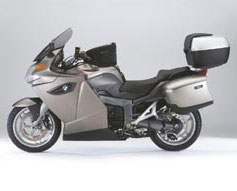
For the mass market, BMW has upgraded three of its K 1200 series bikes to 1300s. The unique BMW turn switches have gone, replaced by a more “normal” style, and instrument design is new as well. Cylinders are 1 millimeter bigger and the stroke is 5.3mm longer to give the added 136cc capacity, and a host of other small changes hang off that like new, shorter conrods, revised mapping and so on. Interestingly, the three bikes have different power and torque figures, so there has been a bit of serious fine-tuning of the engine for specific applications.
A quick shifter is available as an accessory and enables up-changes without getting off the gas or using the clutch. Does anyone need this on a road bike? Or is it just a chance for BMW to show off technology, like the late and unlamented front brake servo? The Bavarians are not the only ones to offer this, of course.
Never mind. The bikes will certainly be no slouches. The faired K 1300 S produces 129kW at 9250rpm and 140Nm at 8250, while the naked K 1300 R puts out 127kW and the same torque at the same revs, but it’s 11kg lighter with a kerb weight of 243kg.
The K 1300 GT has to make do with 118kW at 9000rpm and 135Nm at 8000, but 80 per cent of the torque is already available at 3500rpm. The bike has a host of features such as the ESA electronic suspension adjustment, heated grips and seats, cruise control, GPS and an electric screen. The GT weighs 288kg at the kerb, and should prove a more than ever capable mile muncher even with Australian distances.
That was it in Cologne. But the Bavarians saved something pretty special for Milan: the latest of the F 800 series, the R. To boost performance over the S, the bike gets a new throttle valve system that takes its power output to 64kW at 8000rpm and 86Nm at about 6000. Shorter gearing in the higher gears should make it a ripper. It looks a lot like the K 1300 R and was presented with all sorts of accessories, including full touring gear featuring BMW’s depth-charge-like expandable panniers.
But that’s not all. We can only assume that the design team in Munich has been consuming a lot of highly potent, err, sports drinks because they also showed a truly weird – and in its weird way truly intriguing – bike called the Lo Rider. Based on the boxer engine, it is a kind of kit bike that can be configured in several ways. We’ll just show you one – the basic version – and go into more detail soon, possibly in the launch issue of ARR Cruiser, due a little later in the year.
Love it or hate it, this is one bike you’d really notice on the road!
Buell
The first variant in the 1125 range was on show. It’s the café racer version, the CR, and it looks thoroughly tough but slippery, a bit like a twin-engined fighter or perhaps ground attack jet with its big side scoops. Buell claims it is one of the lightest and most dynamic machines in the category and the Rotax-built V-twin produces a thoroughly respectable 110kW and 111Nm.
Ducati
With the second of its new Monsters on the Cologne stand, styled after the brilliant 696, Ducati is clearly on the way to a completely new Monster family. The 1100’s air-cooled two-valve V-twin produces 70kW and 103Nm, which might sound a little mild after the Buell’s output but should be more than enough to let you rule the road in Monster territory. In both standard and S versions the bike gets a “race-oriented” frame and very light and stiff alloy single-sided swingarm – this contributes to weight savings of 8kg over the already light S2R. As Ducati says, “less is more” also means “less is Monster”.
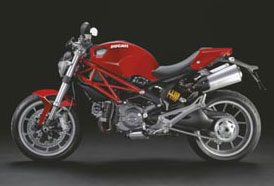 The SportClassic range has been extended with the GT1000 Touring, a travel-ready version of the rider-friendly and versatile GT. It doesn’t come with panniers but it does have a rack and a very smart classic black and white – or white and black – paint job. Is this the perfect all-purpose bike for us in Australia? Maybe, maybe…
The SportClassic range has been extended with the GT1000 Touring, a travel-ready version of the rider-friendly and versatile GT. It doesn’t come with panniers but it does have a rack and a very smart classic black and white – or white and black – paint job. Is this the perfect all-purpose bike for us in Australia? Maybe, maybe…
But the Bolognese saved the big news, and the real heartbreaker, for home territory in Milan. The 1098 has become the 1198 (and of course 1198S) which look like the 1098, but is in fact a totally new bike. It produces 125kW at 9750rpm from its new Testastretta Evoluzione engine and has a dry weight of just 171kg. It also incorporates all of the World Superbike technology derived directly from Troy Bayliss’ 2008 World Championship winning race bike. Data acquisition systems are integrated as standard equipment and Ducati Traction Control is standard on the S.
But for me the 1198 was put in the shade by the stunning new Streetfighter. Equipped with everything that made the superbike a legend, it also looks super street tough. A kind of harder version of the Hypermotard, with the 1098 Testastretta Evoluzione engine, the Streetfighter has an upright and commanding riding position, minimalistic controls and instrumentation and a headlight design you have to see to believe. It actually has evil-looking “eyes”. Upgraded suspension, lighter wheels, traction control and data analysis make the S version. This is going to be a really serious player on the road here in Australia.
Gunbus
When the going gets weird, the Doctor (not that one) used to say, the weird get going. The weird guys from Leonhardt Manufacturing have certainly developed a fair head of steam with their enormous Gunbus 410. It’s true that giant monster bikes have been popping up on every corner lately, but there is a significant difference with the 410: it’s not a one-off, you can buy them. The Gunbus, the “largest ridable motorcycle in the world”, according to the factory, is actually being produced and is available off the showroom floor.
Capacity is 6728cc (the 410 refers to cubic inches) and torque maxes out at 710Nm from the V-twin, and the whole thing is 3.47 metres long. Don’t worry; seat height is only 800mm and yes, it does have reverse. We know you want one, so check www.leonhardtweb.de for more information. Registration in Australia? Someone help that insanely cackling bureaucrat to a chair.
Harley-Davidson
I’m pretty sure you’ve seen all of Milwaukee’s news before, but it was good to see the well thought-out design of the V-Rod Muscle again, and both Willie G and a young lady in fishnet stockings enlivened the Cologne stand. Everything points to continuing H-D success in Australia, where the Muscle may prove the breakthrough the V-Rods need.
Honda
There’s only so much excitement a 125 can generate but the CB125 was the sole new model Honda presented at Cologne. To make up for the lack of oomph, they did show the long-anticipated anti-lock braking on both the CBR600RR and CBR1000RR Fireblade. It will be interesting to see how this catches on in Australia, a market traditionally skeptical of ABS.
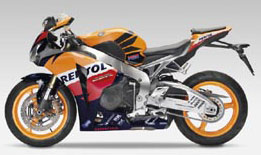 You might well wonder how the market will react to an anti-lock braking system on Honda’s top sports bikes but there’s no arguing with the quality of the technology. Also on show was the Vehicle to Vehicle Communication system that continuously monitors the position, speed and direction of other road users, even in poor visibility. Data on vehicle location, accidents and obstructions is provided to riders and drivers to warn them about possible dangers.
You might well wonder how the market will react to an anti-lock braking system on Honda’s top sports bikes but there’s no arguing with the quality of the technology. Also on show was the Vehicle to Vehicle Communication system that continuously monitors the position, speed and direction of other road users, even in poor visibility. Data on vehicle location, accidents and obstructions is provided to riders and drivers to warn them about possible dangers.
And while there may not have been new models from Honda, there was a pretty spectacular concept bike. The V FOUR looked innovative and slick and telegraphed quite a bit of very new technology. Can’t help thinking that those wheel “spokes” don’t look safe, though.
The V FOUR was also the cynosure of all eyes in Milan, not entirely surprising considering that the only additions to the range shown there were a couple of scooters. That’s big news for Italy, of course – and I’m not kidding! – but it left the rest of the world press wondering just what we were going to see out of Honda next – and more importantly, when. The lack of news is especially disappointing for Australia.
Hyosung
There were a couple of variations on existing models on the Hyosung stand, but the real eye-catcher was the new electric FC-1-2. Pretty spectacularly, err, unusual, but it’s good to see electric technology being introduced in more and more two-wheeled utility vehicles. Will it come here? We don’t know. Should it? You tell us.
Kawasaki
The redesigned Kawasaki 650 carries the ER6 badge in Europe, but we will be getting it as a Ninja. Like the new 250 Ninja, it looks distinctly sporty, although there doesn’t seem to be all that much new under the smart fairing. The sportier ZX-6R is said to be the lightest in class by some 9kg for 2009.
Three new cruisers with an extensively redesigned 1700cc power plant and running gear were eye-catchers on the Kawasaki stands at both shows. The Voyager is the top of the line model and it gets just about the full set of accessories. If you don’t want the full fairing and all the other goodies, you can still go touring in style on one of the new 1700 V-twins. The bike for you there is the Classic Tourer with windscreen and panniers. The bottom of the range is the plain Classic.
These bikes will strengthen Kawasaki’s already substantial share of the Australian cruiser market, with the Voyager a real challenge to Harley’s Ultra Classic. The bike was a huge attraction on the stand in Milan, which is kind of interesting – we would have thought it would be more of a big-country (like Australia) bike.
KTM
The Austrians have been extremely loyal to the EICMA show and have usually reserved their most important launches for Milan. It was no different in 2009.
True to the company’s “Ready to Race” philosophy, the Mattighofen development centre has created the 1190 RC8 R, KTM’s next edition destined for top racing performances. Even more powerful, lighter and more uncompromising than the standard 1190 RC8, KTM expects this bike to have a magnetic attraction for sports riders.
And on the subject of the magic letter “R”: in the northern spring of 2009, KTM will also launch its new large- displacement Supermoto. Based on the 990 Super¬moto, the 990 SM R will offer more power again.
displacement Supermoto. Based on the 990 Super¬moto, the 990 SM R will offer more power again.
KTM has also launched a new motorcycle segment with its 990 Supermoto T – a supermoto tourer. According to Mattighofen, the 990 SM T combines the power, acceleration and maneuverability of an uncompromising Supermoto with the comfort and the touring capabilities of a long-distance racer. Can’t wait to ride that one back here in Australia.
The revamped Adventure series is also ready to roll. The big sporty and travel-ready all-rounder gets more power and even better equipment. And of course there needs to be a top of the line model; alongside the 990 Adven¬ture, the prestige “R” is even more powerful and faster.
Moto Guzzi
The sole novelty on the Guzzi stand in Cologne was the new four-valve 1200 Sport. Now sports bikes are not really Mandello’s strong point, but if you think “GT” rather than “GP” they’re still very serviceable. While the 1200 Sport’s engine is called a V4, it really is just the standard Moto Guzzi transverse V-twin. But it means that Australian V11 riders finally have an upgrade available.
There were “special edition” of several bikes gracing the Milan stand, including a fully kitted touring Stelvio TT, a Griso 8V, a Nevada and a V7 Café Classic in the original V7 green. That looked spectacular.
Moto Morini
With the 1200 Sport, Marabese Design has come up with a naked bike in the classic style of the 1970s, built on Morini’s 9 ½ project. It looks quite different, however, with streamlining that includes a lightweight tail cover that lifts to reveal a comfortable seat for the pillion passenger.
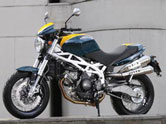 The trellis frame has a reinforced rear to accommodate the lateral cantilever shock absorber connected directly to the hydroformed aluminium swingarm. The left side at the rear features twin silencers with tapered cans and the front has substantial 50mm forks. Special attention, according to Morini, has been given to the ergonomics and the setup: the narrow handlebars and the relationship between the footpegs and seat shifts weight to the front.
The trellis frame has a reinforced rear to accommodate the lateral cantilever shock absorber connected directly to the hydroformed aluminium swingarm. The left side at the rear features twin silencers with tapered cans and the front has substantial 50mm forks. Special attention, according to Morini, has been given to the ergonomics and the setup: the narrow handlebars and the relationship between the footpegs and seat shifts weight to the front.
The Scrambler is an even more unadorned version of the bike. Invented in the 1960s, the Scrambler concept is making a comeback and Moto Morini has interpreted it in its own way. The bike with its 19” front wheel and the over-the-top block tyres looks terrific, especially in black. Is it practical? Probably not, but who cares?
MV Agusta
Confidence is everything, something that Claudio Castiglioni learned many years ago. While there seemed to be no hint of Harley-Davidson’s ownership of MV/Cagiva, the show stand at Milan was huge as always and well supplied with standard and special models. The core display was, of course, of the two Brutales – the 989R and the 1078RR – and the F4 RR 312.
More on MV Agusta in an upcoming issue – I had the chance to see the factory and talk to both Castiglioni and H-D’s man on the ground, Matt Levatich.
Piaggio
The most interesting thing about Piaggio’s new MP3 LT is that it can be ridden on a car licence, a major consideration in Europe where it takes ages and costs a lot of money to get a bike licence. It seems to be some kind of loophole, but not an easy one to close. Don’t hold your breath for the same thing in Australia.
Royal Enfield
India’s bike market is booming, but Indian motorcycle design remains, well, on the “classic” side. The “new” Royal Enfield Bullet Classic at least looks the part. It is actually very attractive in a 1950s sort of way, which will of course attract a lot of people. Well, all right, a few people. We here in Australia tend to like the simplicity of the Enfields, though.
The press material for the launch reckons that this bike is “built of old-fashioned metal” – which could be good, we suppose, or it could be bad.
Suzuki
You’ve met the three novelties from Suzuki by now, but here they are again for a closer look: the upgraded GSX-R1000, a new 650cc naked bike called the Gladius and a 1500cc cruiser that slots in below the M109s. We’d expect the Gladius to carve a real niche for itself in the Australian LAMs market.
At EICMA, Suzuki added a couple of 650 Bandits to the range but made the mistake of supplying an internet address for press information rather than a press kit. Not a good idea, as Kawasaki discovered the year before – and anyway we’re unlikely to get the bikes here.
Triumph
The biggest news from Triumph was a bike we won’t see for another year or more, but there were a few upgrades as well. Triumph’s in-your-face streetbike, the 675 Street Triple, has been joined by an even hotter sister with the introduction of the R version – “like the Street Triple, but harder”, according to Triumph. It gets Nissin four-piston radial front calipers and fully adjustable suspension front and back.
The faired Daytona 675, meanwhile, is 3kg lighter and puts out a remarkable 95kW. There’s an accessory quick shifter if you can’t be bothered with the clutch.
The Bonneville range has grown to three with the addition of the SE. This fits between the current Bonnevilles; it has twin instrument binnacles like the T100 but rolls on cast wheels like the standard Bonnie.
And then there was the bike that isn’t – yet. Possibly the most hotly awaited new Triumph was the belt-drive, twin-cylinder 1500cc Thunderbird cruiser. It looks pretty good but it isn’t scheduled for production until the 2010 model year.
Vespa
The Pontedera factory is marking its 60th birthday by expanding the retro range with scooters such as the GTV 250, in the photo, and the LXV. You’ll meet another new model, the GTS 300 Super, in these pages in the next issue. Given Australian tastes, Vespa’s surge here looks like continuing unabated. In Milan, there was a GTV 250 on the stand with a sidecar fitted. Very popular it was, too!
Yamaha
One of the undoubted highlights of both shows was the new Yamaha R1 with its all-new 998cc engine based on Valentino Rossi’s MotoGP winning bike. Yamaha calls this “the most significant development in engine and chassis technology ever seen in the 11-year history of this legendary motorcycle”. The bike has a new crankshaft with crank pins offset at 90 degrees to deliver more torque and a redesigned frame and bodywork to give it a radical new look.
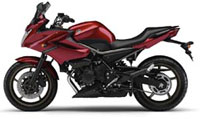 The new VMAX, meanwhile, is being used to show off some of Yamaha’s advanced engine, braking and chassis technology. It’s all new from the YCC-I and YCC-T engine control systems good for providing 148kW and 167Nm of torque, through to the super lightweight aluminium frame and the radial-mounted six-piston front brakes. The bike is clearly aimed at America but it should do very well in Australia, too. We can’t imagine Yamaha making the same mistake as it did with the original VMAX, which wasn’t officially brought into Australia for years.
The new VMAX, meanwhile, is being used to show off some of Yamaha’s advanced engine, braking and chassis technology. It’s all new from the YCC-I and YCC-T engine control systems good for providing 148kW and 167Nm of torque, through to the super lightweight aluminium frame and the radial-mounted six-piston front brakes. The bike is clearly aimed at America but it should do very well in Australia, too. We can’t imagine Yamaha making the same mistake as it did with the original VMAX, which wasn’t officially brought into Australia for years.
Anti-lock braking systems are not just moving into sports bikes, a la Honda. They’re also moving further down the capacity range. Yamaha’s new XJ6 Diversion is available with ABS. It is powered by a newly developed 600cc liquid-cooled, inline four-cylinder engine which, according to Yamaha, “has been specifically designed to produce brisk performance together with an easy, predictable and linear power band”. Can’t be bad, can it?
And Yamaha hasn’t forgotten cruisers, either. Powered by an equally new 942cc air-cooled V-twin SOHC engine designed top produce lots of torque and housed in a long and low chassis that still, apparently, handles well, the Yamaha XVS950A Midnight Star is a classic-looking cruiser in an unusual – for cruisers – capacity class.
More from Milano
Tune in again in the next issue of ARR for some of the more esoteric stuff that found its way into the giant trade fair halls at EICMA and some idea of why it might be worth making the pilgrimage over to Italy some time.
